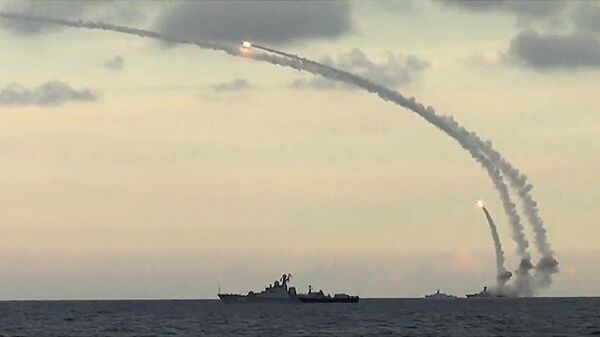Earlier this month, the Defense Department proposed a $582.7 billion budget for the 2017 fiscal year, up from $573 billion this year. Nevertheless, Axe notes, the proposed spending also included cuts in new equipment for all three branches of service.
The reduced allocations for new equipment, the analyst explained, "would help pay for the wars in Syria, Iraq and Afghanistan," and "cover US troop deployments in the Western Pacific and Europe to counter an increasingly aggressive China and Russia, respectively."
"But on examination it's clear that the Pentagon is not cutting back on one particular type of weapon –indeed, it's doubling down with hundreds of millions of dollars in new investment:" anti-ship missiles. "All of a sudden, it seems, destroying enemy warships is a top Pentagon priority."
Why the sudden rush? According to the analyst, "the Navy's crash acquisition of hundreds of long-range, ship-killing missiles reflects the sailing branch's determination to outgun what Robert Work, the deputy defense secretary, described as 'a resurgent Russia and a rising China' on the high seas."
"Defense Secretary Ashton Carter, Work's boss, laid out the argument," Axe explained. "We face competitors who are challenging us in the open ocean, and we need to balance investment in those capabilities –advanced capabilities –in a way that we haven't had to do for quite a while," Carter said, speaking to sailors at Naval Base San Diego earlier this month.
Back during the Cold War, Axe recalled, "the Navy excelled at sinking enemy ships. It possessed two of the world's best anti-ship missiles – the Harpoon and the Tomahawk…With these two weapons, the US Navy was prepared to engage Soviet warships if the Cold War had ever turned hot."
"But after the Soviet Union collapsed in 1991, the US fleet shifted its attention to land," launching "missile and air raids on Iraq, Serbia, Afghanistan, Iraq again, Libya and Syria, among others."
And "when the Chinese navy began its build-up in the early 2000s, and, a few years later, Russia began restoring its own neglected fleet, both countries exploited the American gap. Moscow and Beijing equipped their ships, subs and planes with a wide range of highly capable anti-ship missiles with greater range and destructive power than the aging Harpoon."
"Russia's 27-foot-long Klub missile [launched from the Kalibr-PL and Kalibr-NK platforms], for example, can travel as far as 400 miles [about 640 km] and, during the final moments of its flight, can boost to supersonic speeds to maximize the damage it inflicts on its target. China's YJ-18 is roughly equivalent to the Klub and might even be an illicit copy of the Russian munition," the military analyst alleged.
Worryingly, Axe explained, "Russian and Chinese ships armed with the far-reaching Klubs or YJ-18s can shoot at American warships before the US vessels within range can fire their older Harpoons, which puts the Americans at a serious disadvantage."
These include a 14-foot, 2,100 pound ship or plane-launched missile developed by Lockheed Martin, with a range of over 200 miles, [about 320 km], a new iteration of the Tomahawk featuring a more sensitive tracker/seeker, promising to turn it into a "1,000 mile anti-ship cruise missile", and the SM-6, a 21-foot-long, 3,300 pound missile interceptor, also capable of targeting ships, manufactured by Raytheon.
"Together," Axe suggested, "the three new weapons should begin to tilt the at-sea balance of power back in the US Navy's favor."






